Akademi Dance Film Festival 2021
Akademi Dance Film Festival 2021
Friday and Saturday 19th & 20th March 2021
Reviewed by the Pulse Dance Audience Club
This was the first ever Screen Dance Festival of new and archived films featuring South Asian dance artists. Curated by Suba Subramanian of Akademi and Omari Carter of Motion Dance Collective, the Festival offered a rich selection of films over two days, plus discussions with film-makers and dance artists. The works ranged from new dance films, including first projects of this kind for the makers, to films made by more experienced teams; from very fast production, to those which had been made with more time; from low budget to higher budget. The quality of the dance we saw was excellent throughout, as one would expect; but what distinguished the more satisfying pieces from those which were felt to be less so was the clarity of intention. The scheduled discussions shed light on aspects of the films we had seen; but when the films worked for the viewers, they did so without additional information and explanation.
DAY 1
APOTHEOSIS by Akademi & The Motion Dance Collective (World Premiere)
Dancers: Suhani Dhanki, Elena Catalano, Maryam Shakiba and Khavita Kaur
Odissi and bharatanatyam dancers performed against the backdrop of the imperial grandeur of the British Museum, with the odissi dancers making their way skilfully, with beauty and control, up the steps of the grand staircase, the sound of ghungroos breaking into the silence; and the lone bharatanatyam dancer who seemed to stake her space within the echoing expanse of the Great Court.

The film was read in a number of ways: the living dancers, in their rich costumes, claimed spaces occupied by objects from the past, sculptures once painted but now without colour. How far were the bejewelled dancers also moving artefacts within a space – their jewels and postures mirroring the jewels and postures of the statues on display? Was it ironic? For some, but not for all, the colonial issue loomed large. How far did the dancers disrupt rather than embellish such imperialism? How far do the moving dancers break out of the museum confines? Others felt a lack of connection between the first and the second part and thought that although the dance was so strong, the effect was rather that of a well-executed advertisement for the British Museum.
We learned in the discussion session about time constraints. The British Museum had offered the spaces without charge for two hours after hours when the dancers were there for another project.
Ek Choti si Asha - ‘A Small Dream', by Rachel Davis & Daniel Saul (R&D Studio), Dancer: Hemabharathy Palani
‘In 2018 India was planning to send a small robot called ‘Ek Choti si Asha’ (‘A Small Dream’) to the moon to roam the lunar surface for 14 days. In this film the dancer… creates a woman’s journey across Bangalore in tribute to an audacious venture carrying the aspirations of a billion people.’
The viewers loved this many-layered film, with its ‘alien on earth’, its complexities, and the surprising synergies between film, text and dancer. From the opening low lit, slow moves which conjured the sense of a moon landing; the playing with the backdrop of India as an unknown world; the capturing of the faces of bystanders (old and young) and of India’s landscape (old and new – the pots and the geometric reflective buildings); the discreet reference to the moon; the quiet intensity and dignity of the dancer – and the beautiful conclusion (particularly as a counter to what has been coming from India recently about female oppression), that the first Indian citizen to set foot on the moon will be female.
The film gained a frisson in retrospect as we learned in the discussion session that the Bangalore police had not granted permission to film, so that it was fast ‘guerilla’ filming; and that the crew were chased away by the police at the bus station.
The Place to Face What Must Be by Kadam Dance & Katie Ryan
Katie Ryan was responding to the lines from Matthew 26:38: ‘O my Father, if this cup may not pass away from me, except I drink it, thy will be done’, spoken in the Garden of Gethsemane before Christ’s crucifixion.
The piece was framed by the text, but it allowed also metaphoric interpretations, with a ‘push and pull between specificity and ambiguity’. For one viewer ‘the combination of the title, the quotation from Matthew, the haunting music and the stunning images of the natural world almost inevitably make this a film about the threat of environmental collapse.’ The clarity and focus made it a satisfying and harmonious piece, presented with sensitivity, restraint and delicacy. The emotion came through, without melodrama. The skills of the film-maker and musician harmonised with that of the dancer/choreographer. The soft, natural light came together with the subtle expression in a satisfying way.
NuBody by Sonia Sabri Company
‘This film [explores] the light versus dark, the real versus fairytale versions of female existence. It poses questions about ownership of the female body, womanhood, what the world is teaching our daughters and asks why so many daughters are buried before they get a chance to live?’
Intensity of emotion was powerfully expressed: the protagonist was trapped at the start, in her high-heeled boots, in a confined, sinister, tiled space (we learned in the discussion session that it had been filmed in a morgue); the film was made before the pandemic, but this section resonated with recent experience.
A white screen replaced the first setting. Love and passion became blood and murder. It was disturbing, visually striking and powerful. Was she a migrant woman, was it a dream? The red glass bangles suggested marriage; we learned from the discussion that the string alluded to a Japanese tradition, which one viewer found interesting and thought could have been used for the whole; but it was felt that there were too many ideas and props: the dancing was beautiful, but more editing would have helped make it a tighter film.
Cuppa? by Elena Nebreda Lozano & Avatâra Ayuso
‘A table-top dance, a playful duet between Indian and British approaches to enjoying a cup of tea.’
This piece provided a welcome relief (a tea break). We enjoyed the quirkiness and humour, though it had something of the flavour of a ‘Welcome to India’ advertisement. It was visually very beautiful, with the spices being crushed, the water boiling in the glass kettle, the moving hands. The tea-making was idealised in both settings, and it was suggested that PG tips might have been an effective choice, with the milk going in first; but that would have been our choice, not that of the makers.
Kattam Katti by Pagrav Dance Company
The setting of Kattam Katti is the kite festival in Gujarat, North India, where millions of people from different cities, religions and social classes come together to fly kites in a unique event marking the transition from winter into spring.
This film was ‘delicious, I wanted more of it’. ‘I loved the atmosphere it created with the playful dance, the colours, the music – the musicians were not static, they became part of the choreography – the threads of the kite strings going across the stage and the development of the dance through different sections.’ It evoked conflicts, tensions and resolutions. As it was created from a stage show, it whetted the appetite for the live performance which is due to come!
Day 2
MaMa by Kirsten Newell & Oxana Banshikova
'MaMa is a motherhood-inspired dance film exploring themes of pregnancy and early motherhood.’
The film reflects on the joys and the fears, the exhilaration and exhaustion of becoming a new mum. Bringing together gorgeous videography, an irresistible blend of Celtic and Carnatic music and two dancers performing with sympathy, sensitivity and skill, MaMa does not shy away from some of the darkest feelings that can overcome new parents, but neither does it indulge them. Instead, it observes them and lets them be, before bringing us back to the earth, the light on the water, the gentle resistance of moss underfoot.’ It is a loving film. We loved the heavily pregnant body. We learned in the discussion session that Oxana had found she was pregnant in the middle of the project, and had the baby with her in the discussion – it made pregnancy a normal thing.

It was a compassionate, supportive and inclusive piece. ‘The film had breath, which I enjoyed as a viewer’. It was visually beautiful and needed no filters – it could have been edited a little more judiciously as 'it was occasionally in danger of bordering on the trite' felt one of the contributors.
The Art of Defining Me & Home by Seeta Patel & Kamala Devam
‘In a tick box society where identity has become a commodity… a humorous look at how they as artists are influenced by the expectations and definitions placed upon them.’
This was ‘a witty and thought-provoking set of films about identity, dance and power – including some great bharatanatyam by split pin dolls (more of this please!)’. It pulls apart both identity politics and the politics of funding. Devam responds with increasing physical contortions and urgency to the increasing restrictions and demands placed on her by the ‘interview panel’, while the panel itself perform a neatly co-ordinated set of movements – folding together a paper ‘fortune teller’, jamming a hairclip in place, ensuring at all times that things fit in to what they are ‘meant to be’ and don’t stray too far from the norm…
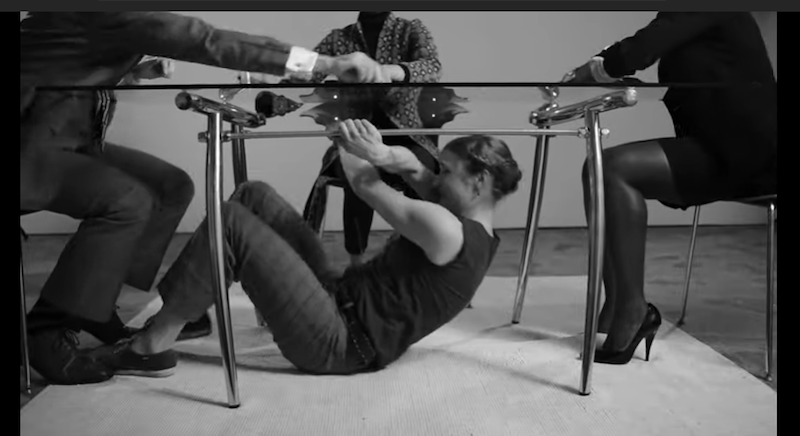
In Home, in an aesthetically different take on the theme, Patel appears to try and avoid the identity placed upon her, but whichever door she goes through she returns to the same place – and however flexibly and imaginatively she tries to escape the box she is placed in, it seems to be impossible. The only route seems to be surrender as Patel finally imprints her expected identity on her forehead, the mirror thus dictating her reflection rather than responding to what she is. One viewer was disappointed that she accepted the bindi – she would have liked her not to conform; although another responded differently and felt that her body language suggested that she had found her voice and confidence – is she embracing her identity?
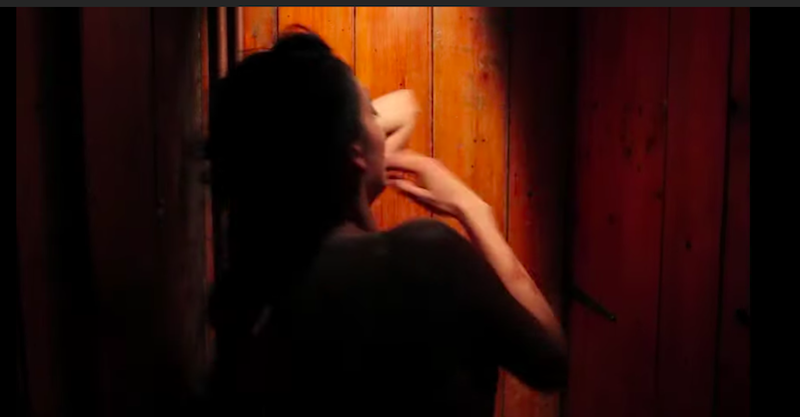
Virtual Ghost by Kesha Raithatha & InkMilk
This was seen as an ode to everyday spaces, as the dancer danced through and was projected onto the walls and car parks of her home town, Leicester. This pleased one viewer because ‘I’ve always wanted to see images of Indian dance and movement in public spaces.’ ‘I loved this, it was so refreshing to see an aesthetic not grounded in conventional notions of beauty - the eeryness was so welcome! The still buildings with the moving projections felt empowering – the buildings of our city might be old and colonial and permanent, but how we use them, how we contextualise them is all up for grabs.’ ‘I really enjoyed the surprising visuals – the silhouettes, shapes and shadows conjured by the dancing and the clever videography (though the visual effects were at times over-used).
The film effectively conjured the ghostliness of the first lockdown with its haunting music, and the dancer was transported from walls to roofs to roads with a melting insubstantiality. Two favourite moments were the cameo appearance of a woman holding her sari up to avoid the puddles, hurrying along with her shopping under dancing shadows, and another, that of an old lady trundling along with her shopping trolley.’ ‘It had “a very British aesthetic”, partly because of the street furniture, you know what country you’re in.’ It ‘almost had a pop video cool about it’. With reference to the title, it had an eerie feeling. ‘After months of Zoom calls, if you go out, do you see people, do you see screens?’
Catch The Bird Who Won't Fly by Amina Khayyam Dance Company
This tells four individual stories, narrating the real-life experience of women from South Asian communities, who have suffered domestic violence or sexual abuse
This film made particularly painful viewing following a couple of weeks in which the spotlight has been on violence against women, reminding us that though outside the home is not a safe space, home is not necessarily any safer. Artistically the film is beautiful – the way Amina develops the kathak vocabulary to convey a sense of anguish is remarkable; and the way the animation interacts with the dancing is clever and effective – particularly where Amina enjoys the radiance of the butterflies, the sudden fall of rain, or releases a ribbon of birds streaming from her mouth in a silent scream. The animation is a useful device – it makes it not about one person. The part of the film in which Mithun plays the son struggling with the pain and guilt of his mother’s death is very moving, highlighting how the whole family suffers through domestic violence. ‘I really related to this sense of filial duty that exists in our culture, and how sometimes that can feel impossible to fulfill against the oppression that faces our elders.’ Mithun moves convincingly between the son remembering his mother’s tenderness and his inability to reconcile himself with what has happened.
As the film moves to its conclusion, flitting between the three dancers, the screen fracturing to convey a sense of this happening over and over again, the numbers of birds (women’s souls?) that whirl through the sky is a stark reminder of the truth – as Jess Philips reminds us, reading out the names of the women (on average 2 a week) who are killed in the UK alone.
Bhairava by Marlene Millar & Philip Szporer and Discussing Bhairava by Marlene Millar & Philip Szporer
‘Bhairava’ evokes facets of Shiva, the Lord of Dance, as both the destroyer of evil and the guardian of time. Dancer: Shantala Shivalingappa
Every element of this film was outstanding – performance, direction, cinematography, costume. ‘I responded to this piece viscerally. I felt, I did not think. It is a stunning piece: the drama of the landscape; the music, part chant, part prayer; the vigour, detail and clarity of the dancing combine to make this piece utterly compelling. Shantala speaks of the rawness, the return to the elements, the grandeur and terror of Shiva and of time – and all this comes through this film – opening up a sense of the terror and wonder of what might be beyond.’ ‘There was a cleanliness to the ferocity in her movement. One didn’t feel she was out of control in her rage.’ ‘It felt minimalist. The vision had so much clarity that at no point did you feel inundated or distracted. It drew you in and kept you fixed.’
Discussing Bhairava would have been better as part of the evening as it broke the flow of dance films.
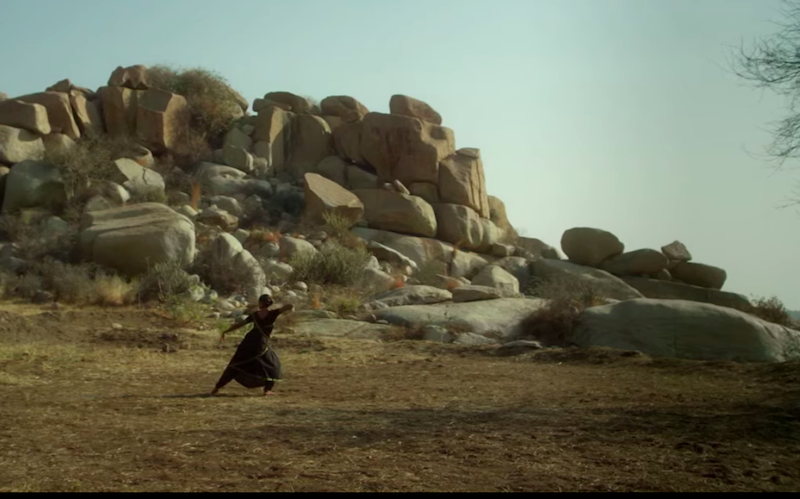
The screenings closed with three short Akademi Screendance Commissions.
I Am Your Skin by Jaivant Patel Dance
‘This dance film challenges perceptions of gender and questions how we frame sexuality.’
‘This was an interesting piece, and I enjoyed the repeated almost invocation of the poem. The images of the sand/the trailing sari (in the image below) are attractive in themselves but did not necessarily illuminate the central theme of challenging gender. The themes could have been developed more. One would have liked to see a bit more dance, a bit more back, shoulders, feet.
It is an eminently watchable film which will benefit from further development.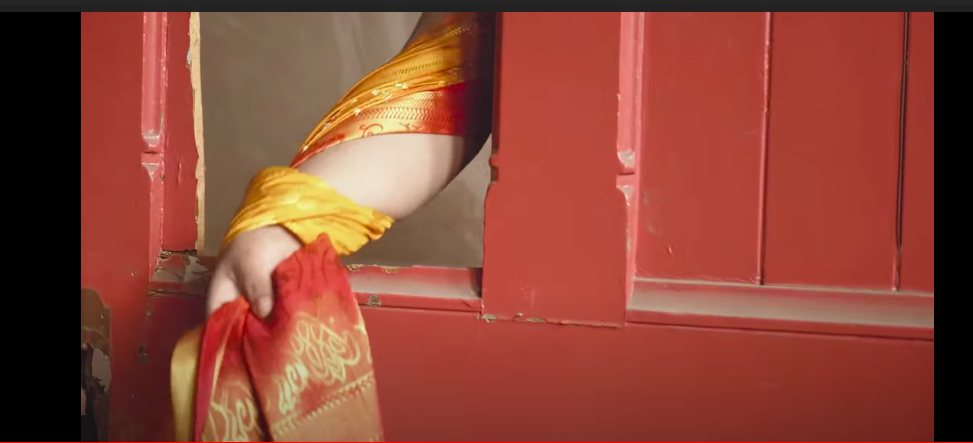
Where The Walls Do Not Contain Me by Archana Ballal & Luisa Lazzaro
‘Stay at Home’ [was] the overwhelming message over the past year during the Covid-19 Pandemic. This film is inspired by the experience of some for whom ‘home’ is not always a place that is stable, safe, and physically and emotionally containing.
This was a short but effective piece, summoning the sense of being trapped within a loop before the final break for freedom. One could feel the protagonist’s frustration in the use of the wall, the lunge movement, confinement. The end shot was powerful, with her running until she becomes a speck and disappears.
nīlah (Blue) by Kaajel Patel
‘I began this artwork thinking about feelings of stagnation & frustration in the body. This was linked to lockdown & feeling physically ‘stopped’ as an artist.
‘This was a visually striking piece, which certainly lives up to its name – I enjoyed the fun shots of blue feet and hands reaching into the air as if discovering themselves.’ We liked the cheekiness, even though it was about her frustration. Blue was the colour of lockdown for Patel. We learned in the discussion session that ‘blue has.. followed me throughout my life… I'm absolutely terrified of huge amounts of water… I grew up falling asleep downstairs quite a lot.. my dad would listen to Jaws… I grew up petrified of water and blue. In my artistic practice, I do use blue as a way of challenging myself.’ It was visually very considered. The use of chalk to outline her face and hands reinforced the way we look at each other on screens in two dimensions; it also rather uncomfortably recalled the chalk line around a dead body.
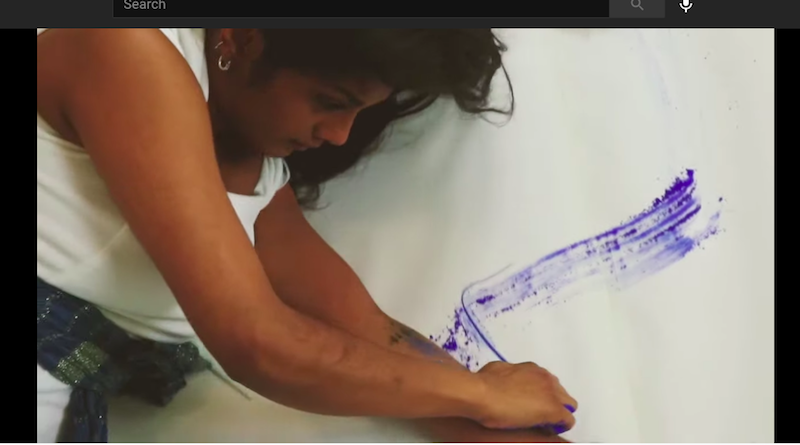
There were two outstanding discussions with artist Hetain Patel and Akademi Artistic Director Suba Subramaniam and film-maker Sima Gonsai with Omari ‘Motion’ Carter. However, there was a strong feeling that the post-performance discussions with the artists were too long. Although it is interesting to hear the inspirations and thought-processes of the artists, the works need to stand by themselves.
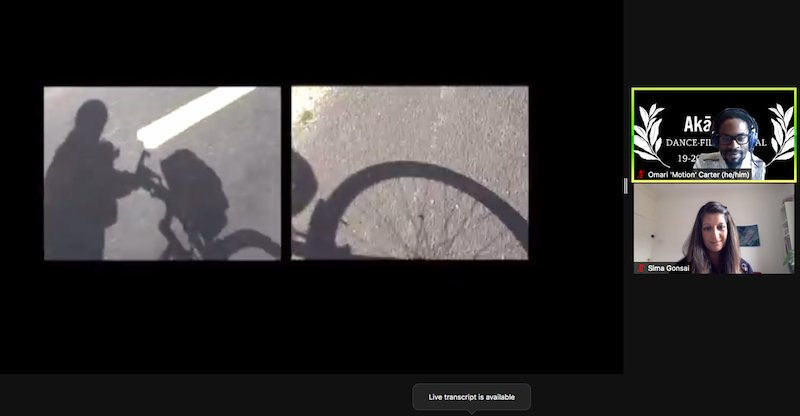
The festival was rich and various – a credit to Akademi and the artists. We liked the fact that it was so open, in terms of experience and budget. An interesting scratch piece can stand beside a work like Bhairava. The commissions did feel like first steps, but valid ones. However, the two days felt a bit overpowering. We would have liked the films to be available over the course of a week, if not longer; as it was, we didn’t feel we could do justice to them. We felt the need of thinking time. These two days should not be the end of the event, we would like to be able to view the films again and be made available as material for researchers. Some important information was also missing which would have helped the viewers: the dates the films were made and their length.
It would have been interesting to hear audiences’ perspectives on how they had received the films. This was an element that was lacking.
With thanks to all the contributors to the discussion:
Shivaangee Agrawal, Parbati Chaudhury, Sanjeevini Dutta, Magdalen Gorringe, Hiten Mistry, Gopa Roy, Bisakha Sarker, Gitta Wigro. Compiled by Gopa Roy.
All images are screenshots from the Festival.




















